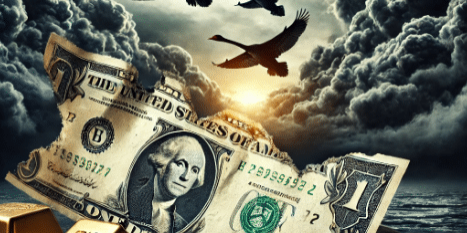
The Black Swan is Circling: Why the U.S. Dollar is on the Brink of Collapse
Written by Bill Brocius
The U.S. Dollar is Losing Ground—Fast
Right now, the dollar still reigns supreme in global finance. It's used in 88% of foreign exchange transactions. But make no mistake—its dominance is eroding. Since 2000, the dollar’s share of global reserves has dropped from 71% to just 58%, and Taleb warns that this decline has accelerated, especially after the Russia sanctions.
Central banks around the world took note of how quickly the U.S. can weaponize its currency. The result? A rush to alternatives, with gold being the top choice. In fact, central banks have been hoarding gold at levels we haven’t seen in decades. Why? Because they no longer trust the U.S. dollar to be the stable store of value it once was.
Taleb put it bluntly: “People nominally conduct transactions in dollars, but they don’t store it in dollars, and that is what the problem is.”
De-Dollarization: The Great Unraveling
Taleb’s fears are part of a broader trend known as de-dollarization. This is the slow but steady process of the world shifting away from relying on the U.S. dollar as the primary reserve currency. And it's happening at a time when the U.S. government is sinking deeper into debt, with rising interest expenses exacerbating an already bloated budget deficit.
Here’s the crux of the problem: the U.S. Treasury must keep issuing bonds to finance its spending spree. And who buys these bonds? Foreign investors, for the most part. But with the U.S. showing its willingness to freeze foreign assets, investors are starting to question the safety of dollar-denominated assets. If those buyers lose confidence in the dollar, who will keep financing the U.S. debt machine?
“That’s exactly why I’m afraid,” Taleb said, pointing back to the asset confiscation. “It doesn’t encourage people to invest in your currency.”
The Fragile State of the Markets
It’s not just the dollar that has Taleb on edge. He also warns that today’s markets are more fragile than they’ve been in decades. What’s driving the current market rally? A handful of tech giants riding high on artificial intelligence hype. But Taleb sees echoes of past bubbles. Like the dot-com boom, this euphoria could evaporate, leaving the market in shambles.
Taleb pointed to a broader market complacency—a mindset fostered by years of low interest rates that convinced investors they didn’t need to play it safe. Now, with valuations reaching absurd levels and mixed economic signals creating confusion, the stage is set for a brutal correction.
And it’s not just Taleb sounding the alarm. His colleague at Universa Investments, Mark Spitznagel, recently warned that the uninversion of the yield curve is signaling an impending recession. For years, the inverted yield curve has been a red flag for economic trouble, and now that it’s starting to unwind, it could mark the beginning of a much larger crisis.
“That’s when you enter black swan territory,” Taleb noted. “Black swans always lurk, but now we’re in their territory.”
What Does This Mean for You?
Taleb’s warnings paint a picture of a U.S. dollar in decline, fragile markets on the brink, and an economic system teetering on the edge of collapse. This is not a time for complacency. If you're sitting on assets tied to the U.S. dollar, it's time to think strategically about how to protect yourself.
The dollar’s downfall will not happen overnight, but the signs are clear. The world is shifting away from reliance on the greenback, and if you’re not prepared, you could get caught in the collapse.
Now is the time to act.
Download my free ebook, "7 Steps to Protect Your Account from Bank Failure" and learn how to safeguard your assets from the coming financial storm. Don’t wait until the system unravels—join my Inner Circle for exclusive insights and take control of your financial future before it’s too late.
The black swan is circling, and this time, it’s coming for the U.S. dollar.
The financial market is crumbling and EVERYONE will be affected. Only those who know what's going on and PREPARE will survive... dare we say thrive. Our 7 Simple Action Items to Protect Your Bank Account will give you the tools you need to make informed decisions to protect yourself and the ones you love.









